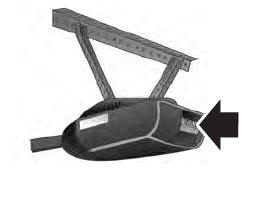Refer to Wiring Diagrams Cell 90 for schematic and connector information.
Normal Operation and Fault Conditions
REFER to: Exterior Lighting - Overview (417-01 Exterior Lighting, Description and Operation).
REFER to: Exterior Lighting - System Operation and Component Description (417-01 Exterior Lighting, Description and Operation).
DTC Fault Trigger Conditions
| DTC |
Description |
Fault Trigger Condition |
| BCM B1265:01 |
Left Rear Turn Lamp Feedback: General Electrical Failure |
A continuous memory DTC that sets when the BCM detects an electrical
failure from the LH rear turn lamp outage circuit when the turn lamp is
activated.
|
| BCM B1266:01 |
Right Rear Turn Lamp Feedback: General Electrical Failure |
A continuous memory DTC that sets when the BCM detects an electrical
failure from the RH rear turn lamp outage circuit when the turn lamp is
activated.
|
| BCM B1497:01 |
Left Front Turn Lamp Feedback: General Electrical Failure |
A continuous memory DTC that sets when the BCM detects an electrical
failure from the LH front turn lamp outage circuit when the turn lamp is
activated.
|
| BCM B1498:01 |
Right Front Turn Lamp Feedback: General Electrical Failure |
A continuous memory DTC that sets when the BCM detects an electrical
failure from the RH front turn lamp outage circuit when the turn lamp is
activated.
|
Possible Sources
- Wiring, terminals or connectors
- Headlamp assembly
- Rear lamp assembly
-
BCM
|
| F1 DETERMINE IF THE VEHICLE IS EQUIPPED WITH A TRM (TRAILER MODULE)
|
-
Using a diagnostic scan tool, perform a network test.
Does the test indicate the presence of a TRM and pass the network test?
| No |
If a TRM is present and did not pass the network test, DIAGNOSE no communication with the TRM .
If a TRM is not present, GO to F4
|
|
| F2 CHECK THE RECORDED DIAGNOSTIC TROUBLE CODES (DTCS) FROM THE BCM (BODY CONTROL MODULE)
AND TRM (TRAILER MODULE)
SELF-TEST |
-
Using a diagnostic scan tool, perform the BCM and TRM self-test.
Are any communication Diagnostic Trouble Codes (DTCs) present?
| Yes |
DIAGNOSE the communication Diagnostic Trouble Codes (DTCs) first.
For BCM Diagnostic Trouble Codes (DTCs), FCIM
For TRM Diagnostic Trouble Codes (DTCs),
REFER to: Trailer Lamps (417-01 Exterior Lighting, Diagnosis and Testing).
|
|
| F3 ISOLATE THE TRM (TRAILER MODULE)
|
-
Activate the suspect turn lamps.
Do the turn lamps operate correctly?
|
| F4 DETERMINE IF A TURN LAMP IS INOPERATIVE |
-
While observing the front and the rear turn lamps, place the LH
steering column multifunction switch in the left and right turn
positions.
Is any turn lamp inoperative?
| Yes |
For a front turn lamp, GO to F5
For a rear turn lamp, GO to F11
|
| No |
For a front turn lamp, GO to F7
For a rear turn lamp, GO to F13
|
|
| F5 CHECK THE FRONT TURN LAMP |
-
Disconnect: LH Headlamp C1021A or RH Headlamp C1041A.
-
While observing the front turn lamps, place the LH steering column multifunction switch in the inoperative turn position.
Does the turn signal indicator flash fast?
|
| F6 CHECK THE FRONT TURN LAMP OUTAGE CIRCUIT FOR A SHORT TO VOLTAGE |
-
Measure:
Click to display connectors
LH Turn Lamp
|
Positive Lead
|
Measurement / Action
|
Negative Lead
|
|
C1021A-10
|
.jpg)
|
Ground
|
Click to display connectors
RH Turn Lamp
|
Positive Lead
|
Measurement / Action
|
Negative Lead
|
|
C1041A-10
|
.jpg)
|
Ground
|
Is any voltage present?
|
| F7 CHECK THE FRONT TURN LAMP OUTAGE CIRCUIT FOR A SHORT TO GROUND |
-
Disconnect: LH Headlamp C1021A or RH Headlamp C1041A.
-
Measure:
Click to display connectors
LH Turn Lamp
|
Positive Lead
|
Measurement / Action
|
Negative Lead
|
|
C1021A-10
|
.jpg)
|
Ground
|
Click to display connectors
RH Turn Lamp
|
Positive Lead
|
Measurement / Action
|
Negative Lead
|
|
C1041A-10
|
.jpg)
|
Ground
|
Is the resistance greater than 10,000 ohms?
|
| F8 CHECK THE FRONT TURN LAMP OUTAGE CIRCUIT FOR AN OPEN |
-
Measure:
Click to display connectors
LH Turn Lamp
|
Positive Lead
|
Measurement / Action
|
Negative Lead
|
|
C1021A-10
|
.jpg)
|
C2280C-6
|
Click to display connectors
RH Turn Lamp
|
Positive Lead
|
Measurement / Action
|
Negative Lead
|
|
C1041A-10
|
.jpg)
|
C2280C-17
|
Is the resistance less than 3 ohms?
|
| F9 CHECK THE HEADLAMP INTERNAL HARNESS |
-
Place the headlamp switch in the OFF position.
-
CHECK the internal headlamp harness for open or shorted circuits and damaged or pushed-out pins.
Is the headlamp internal harness OK?
| No |
REPAIR the harness. If the harness cannot be repaired, INSTALL a new headlamp assembly.
REFER to: Headlamp Assembly (417-01 Exterior Lighting, Removal and Installation).
|
|
| F10 CHECK THE ADAPTIVE FRONT LIGHTING MODULE |
-
Remove the suspect adaptive front lighting module.
-
Substitute the known good adaptive front lighting module from the opposite headlamp.
-
Using a diagnostic scan tool, carry out the BCM
LIN New Module Initialization.
Does the suspect headlamp operate?
| Yes |
REMOVE the known good adaptive front lighting module. INSTALL a new adaptive front lighting module.
REFER to: Adaptive Front Lighting Module (417-01 Exterior Lighting, Removal and Installation).
|
| No |
REMOVE the known good adaptive front lighting module. INSTALL a new headlamp assembly.
REFER to: Headlamp Assembly (417-01 Exterior Lighting, Removal and Installation).
|
|
| F11 CHECK THE REAR TURN LAMP |
-
Disconnect: Inoperative LH Rear Lamp C412 or RH Rear Lamp C415.
-
While observing the rear turn lamps, place the LH steering column multifunction switch in the inoperative turn position.
Does the turn signal indicator flash fast?
| Yes |
INSTALL a new rear lamp assembly.
REFER to: Rear Lamp Assembly (417-01 Exterior Lighting, Removal and Installation).
|
|
| F12 CHECK THE REAR TURN LAMP OUTAGE CIRCUIT FOR A SHORT TO VOLTAGE |
-
Measure:
Click to display connectors
LH Turn Lamp
|
Positive Lead
|
Measurement / Action
|
Negative Lead
|
|
C412-4
|
.jpg)
|
Ground
|
Click to display connectors
RH Turn Lamp
|
Positive Lead
|
Measurement / Action
|
Negative Lead
|
|
C415-4
|
.jpg)
|
Ground
|
Is any voltage present?
|
| F13 CHECK THE REAR TURN LAMP OUTAGE CIRCUIT FOR A SHORT TO GROUND |
-
Disconnect: Inoperative LH Rear Lamp C412 or RH Rear Lamp C415.
-
Measure:
Click to display connectors
LH Turn Lamp
|
Positive Lead
|
Measurement / Action
|
Negative Lead
|
|
C412-4
|
.jpg)
|
Ground
|
Click to display connectors
RH Turn Lamp
|
Positive Lead
|
Measurement / Action
|
Negative Lead
|
|
C415-4
|
.jpg)
|
Ground
|
Is the resistance greater than 10,000 ohms?
|
| F14 CHECK THE REAR TURN LAMP OUTAGE CIRCUIT FOR AN OPEN |
-
Measure:
Click to display connectors
LH Turn Lamp
|
Positive Lead
|
Measurement / Action
|
Negative Lead
|
|
C412-4
|
.jpg)
|
C2280D-31
|
Click to display connectors
RH Turn Lamp
|
Positive Lead
|
Measurement / Action
|
Negative Lead
|
|
C415-4
|
.jpg)
|
C2280D-44
|
Is the resistance less than 3 ohms?
|
| F15 CHECK THE REAR LAMP ASSEMBLY |
-
REMOVE the suspect rear lamp assembly.
REFER to: Rear Lamp Assembly (417-01 Exterior Lighting, Removal and Installation).
-
Substitute the known good rear lamp assembly from the rear lamp headlamp.
-
CLEAR the Diagnostic Trouble Codes (DTCs), REPEAT the BCM self-test
(required to enable the lamp output driver) and cycle the ignition OFF
and ON. TEST the system for normal operation.
Does the suspect turn signal lamp and indicator operate correctly?
| Yes |
REMOVE the known good rear lamp assembly. INSTALL a new rear lamp assembly.
REFER to: Rear Lamp Assembly (417-01 Exterior Lighting, Removal and Installation).
|
|
| F16 CHECK FOR CORRECT TRM (TRAILER MODULE)
OPERATION |
-
Disconnect and inspect all TRM and all related in-line connectors.
-
Repair:
-
corrosion (install new connector or terminals – clean module pins)
-
damaged or bent pins – install new terminals/pins
-
pushed-out pins – install new pins as necessary
-
Reconnect the TRM and all related in-line connectors. Make sure they seat and latch correctly.
-
Operate the system and determine if the concern is still present.
Is the concern still present?
| Yes |
CHECK OASIS for any applicable service articles: TSB , GSB , SSM or FSA
. If a service article exists for this concern, DISCONTINUE this test
and FOLLOW the service article instructions. If no service articles
address this concern, INSTALL a new TRM .
REFER to: Trailer Module (TRM) (417-01 Exterior Lighting, Removal and Installation).
|
| No |
The system is operating correctly at this time. The
concern may have been caused by module connections. ADDRESS the root
cause of any connector or pin issues.
|
|
| F17 CHECK FOR CORRECT BCM (BODY CONTROL MODULE)
OPERATION |
-
Disconnect and inspect all BCM and all related in-line connectors.
-
Repair:
-
corrosion (install new connector or terminals – clean module pins)
-
damaged or bent pins – install new terminals/pins
-
pushed-out pins – install new pins as necessary
-
Reconnect the BCM and all related in-line connectors. Make sure they seat and latch correctly.
-
Operate the system and determine if the concern is still present.
Is the concern still present?
| Yes |
CHECK OASIS for any applicable service articles: TSB , GSB , SSM or FSA
. If a service article exists for this concern, DISCONTINUE this test
and FOLLOW the service article instructions. If no service articles
address this concern, INSTALL a new BCM. Refer to the appropriate Removal and Installation procedure in Section 419-10.
.
|
| No |
The system is operating correctly at this time. The
concern may have been caused by module connections. ADDRESS the root
cause of any connector or pin issues.
|
|
 PINPOINT TEST A: THE TURN SIGNAL FUNCTION IS INOPERATIVE OR ALWAYS ON
PINPOINT TEST A: THE TURN SIGNAL FUNCTION IS INOPERATIVE OR ALWAYS ON PINPOINT TEST B: ONE FRONT TURN SIGNAL LAMP IS INOPERATIVE OR ALWAYS ON
PINPOINT TEST B: ONE FRONT TURN SIGNAL LAMP IS INOPERATIVE OR ALWAYS ON PINPOINT TEST C: ONE REAR TURN SIGNAL LAMP IS INOPERATIVE OR ALWAYS ON
PINPOINT TEST C: ONE REAR TURN SIGNAL LAMP IS INOPERATIVE OR ALWAYS ON PINPOINT TEST D: ONE EXTERIOR MIRROR TURN SIGNAL LAMP IS INOPERATIVE OR ALWAYS ON
PINPOINT TEST D: ONE EXTERIOR MIRROR TURN SIGNAL LAMP IS INOPERATIVE OR ALWAYS ON PINPOINT TEST E: THE HAZARD LAMP FUNCTION IS INOPERATIVE OR ALWAYS ON
PINPOINT TEST E: THE HAZARD LAMP FUNCTION IS INOPERATIVE OR ALWAYS ON PINPOINT
TEST F: THE TURN SIGNAL INDICATOR FLASHES FAST WHEN NO TURN SIGNAL
LAMPS ARE INOPERATIVE OR DOES NOT FLASH FAST WHEN A TURN SIGNAL LAMP IS
INOPERATIVE
PINPOINT
TEST F: THE TURN SIGNAL INDICATOR FLASHES FAST WHEN NO TURN SIGNAL
LAMPS ARE INOPERATIVE OR DOES NOT FLASH FAST WHEN A TURN SIGNAL LAMP IS
INOPERATIVE PINPOINT TEST G: B1D36:09
PINPOINT TEST G: B1D36:09  PINPOINT TEST H: ONE CORNERING LAMP IS INOPERATIVE OR ALWAYS ON
PINPOINT TEST H: ONE CORNERING LAMP IS INOPERATIVE OR ALWAYS ON  Trailer Lamps. Diagnosis and Testing
Trailer Lamps. Diagnosis and Testing Headlamp Adjustment. General Procedures
Headlamp Adjustment. General Procedures

 PINPOINT TEST A: THE TURN SIGNAL FUNCTION IS INOPERATIVE OR ALWAYS ON
PINPOINT TEST A: THE TURN SIGNAL FUNCTION IS INOPERATIVE OR ALWAYS ON.jpg)
.jpg)